Before you can begin running any sort of analysis or quantity, you have to know what items matter. Various municipalities, states, and review agencies have their own lists of items and methods of breaking down the quantities involved in a typical development project.
There are three main files associated with quantity takeoff in Civil 3D; the pay item list, the pay item categorization file, and the formula file. Each file serves a different purpose and is stored externally to the project. Once a file has been associated to a DWG, the path to the external file is stored with the DWG.
Pay Item List When preparing quantities, different types of measurements are used based on the items being counted. Some are simple individual objects such as light posts, fire hydrants, or manholes. Only slightly more complicated are linear objects such as road striping, or area items such as grass cover. These measurements are also part of the pay item list.
Pay Item Categorization File In any project, there can be thousands of items to tabulate. To make this process easier, most organizations have built up pay categories, and Civil 3D makes use of this system in a categorization file. Civil 3D includes an option to create favorite items that are used most frequently.
Formula File The formula file is used when the unit of measure for the pay item needs to be converted or calculated based on another value. For example, asphalt for a parking lot is usually paid for by the ton, but it is much easier to get the area out of CAD. You can set up a formula that converts square feet into tons, taking into account an assumed depth and density. Later in this chapter, you will create a formula that relates length to light poles along the road.
There is a key-in available if you need to disconnect your pay item and formula files from the drawing. At the command line you can type DETACHQTOFILES. The Undo command will not reconnect them if you type this in accidentally.
In the next section, you will learn how to connect the needed pay item files and create favorites.
Pay Item Favorites
Your Civil 3D file will “remember” which files it needs to correctly assess quantities. The favorites list is also stored as part of the DWG. The favorites list is a separate category that can be populated for quick access to commonly used pay items.
In this exercise, you’ll look at how to open a pay item and categorization files and add a few items to the favorites list for later use:
1. Start a new drawing based on the template of your choice.
2. From the Analyze tab’s QTO panel, select QTO Manager (see Figure 18-1) to display the QTO Manager palette.
Figure 18-1: The QTO tools on the Analyze tab
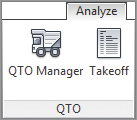
3. Click the Open button at the top left of the palette to display the Open Pay Item File dialog.
4. From the Pay Item File Format drop-down list, select CSV (Comma Delimited).
5. Click the Open button next to the Pay Item File text box to display the Open Pay Item File dialog.
6. Navigate to the Getting Started folder and select the Getting Started.csv file. In Windows Vista and Windows 7, this file is found in C:ProgramDataAutodeskC3D2012enuDataPay Item DataGetting Started.
7. Click Open to select this pay item file.
8. Click the Open button next to Pay Item Categorization File to browse for the file.
9. Navigate to the Getting Started folder and select the Getting Started Categories.xml file. Click Open to select the file. Your display should look similar to Figure 18-2.
Figure 18-2: Open Pay Item File dialog
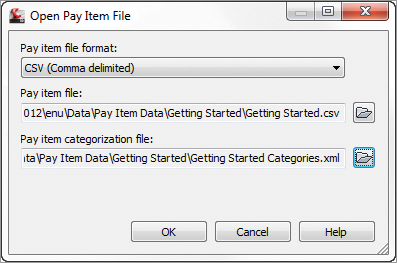
10. Click OK to close the Open Pay Item File dialog, and Panorama will now be populated with a collection of divisions. These divisions came from the Getting Started Categories.xml file.
11. Expand the Division 200 Group 201 Section 20101 branches, and select the item 20101-0000 CLEARING AND GRUBBING, as shown in Figure 18-3.
Figure 18-3: Selecting a pay item to add as a favorite
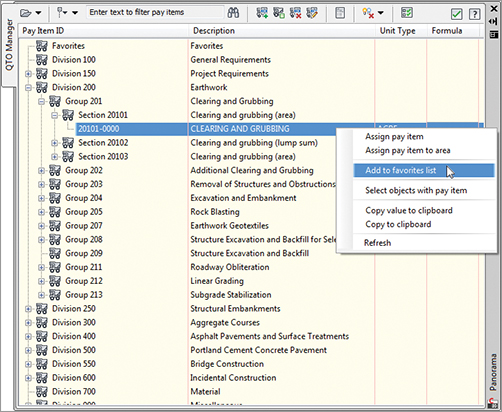
12. Right-click and select Add To Favorites List.
13. Expand a few other branches to familiarize yourself with this parts list. Add the following to your favorites in preparation for the next exercise:
- 60404-3000 Catch Basin, Type 3
- 61106-0000 Fire Hydrant
- 61203-0000 Manhole, Sanitary Sewer
- 63401-0600 Pavement Markings, Type C, Broken
14. Save the drawing as QTO Practice.dwg and keep it open for the next exercise.
When complete, your QTO Manager should look similar to Figure 18-4.
Figure 18-4: A favorites list within the QTO Manager
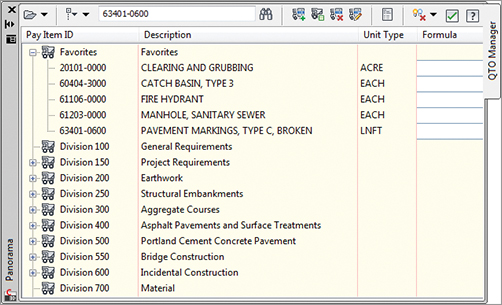
Civil 3D ships with a number of pay item list categorization files, but only one actual pay item list. This avoids any issue with out-of-date data. One commonly used categorization type found in the C:ProgramDataAutodeskC3D2012enuDataPay Item DataCSI folder is MasterFormat. In the United States folder, you can also find categorization files for AASHTO, Federal Highway Administration, and several states’ DOT formats. The pay item files that install with the software are intended to be examples. Contact your reviewing agency for access to their pay item list and categorization files if they’re not already part of the Civil 3D product.
Once you have pay items to choose from, it’s time to assign them to your model for analysis.
Searching for Pay Items
In the upper left of the QTO Manager palette is an extremely handy search tool. If you don’t know what category an item is listed under, you can type it in the field to the left of the binoculars icon.
When you first click the binoculars icon to execute the search, it will appear as if nothing happened. That’s because the categories are getting in the way of the listing. To see an uncategorized look at the list your search produced, select Turn Off Categorization from the drop-down to the left of the search field, as shown in Figure 18-5.
Figure 18-5: Choose Turn Off Categorization to see the results of your search.
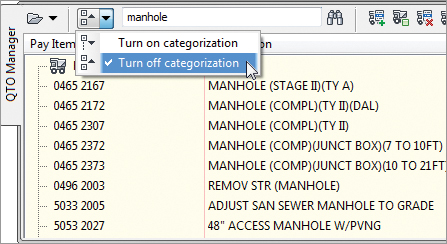
In the following exercise, you will use the search functionality to add items to your favorites list:
1. Continue working in the file that you created in the previous exercise.
2. If it is not already open, go to the Analyze tab and click the QTO Manager button to open it.
3. To the left of the search field, click the drop-down to select Turn Off Categorization.
4. In the search field of the QTO Manager type grandi and then click the binoculars icon. Your search should result in three types of trees. Right-click on the first item, FAGUS GRANDIFLORA, and select Add To Favorites List.
5. Using the same search technique, add the following item to the favorites list:
63620-0500 Pole, Type Washington Globe No. 16
6. Save the drawing.
